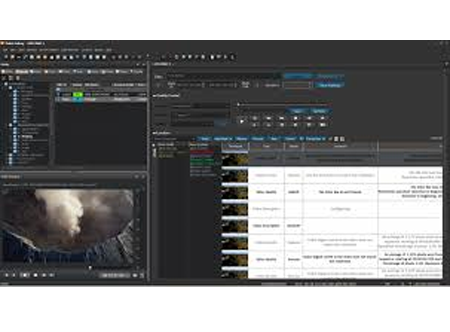Content producers must re-invent their business models to capture new markets and reduce production costs.The first step to this is to implement a proper media asset management system, according to Raoul Cospen Were all media asset managers. Theres the pile of CDs on the shelf and your iTunes collection, managed somewhere on your disk by […]

Content producers must re-invent their business models to capture new markets and reduce production costs.The first step to this is to implement a proper media asset management system, according to Raoul Cospen
Were all media asset managers. Theres the pile of CDs on the shelf and your iTunes collection, managed somewhere on your disk by Apple. Your photos are likely to be placed on several backup drives using different directory schemes.
Its a mess but similar to how media is managed in major companies. Assets are distributed across multiple locations and organised following different schemes. It can be hard to find and use an asset in one place if it was created in another. Traditional media is being challenged by new realities. Content producers must re-invent their business models to capture new markets and reduce production costs. When they turn to their existing infrastructures, they find that multiple production islands are inefficient. Valuable assets are in inaccessible libraries. Metadata are poorly maintained and not carried through the process. Its expensive to set up new business processes.
Moving to a file-based workflow is a good start, but two further steps are needed: the integration of production islands under a single media asset management (MAM) system, and the orchestration of business processes using business process management (BPM).
Heres a look at how a MAM workflow for programme preparation and multi-platform delivery can help you monetise content and succeed in a multiscreen world.
The Challenges
There are dual challenges: simplifying the creative process and making the best possible end-product.
Inside a typical content factory, you see multiple production teams working on different content. Each team has its own VTRs, editing bays, systems, and storage. Executives are finding resource redundancies difficult to support; and vertical production units are not easily repurposed for new business opportunities.
Modern consumers want rich and interactive experiences. Production systems must handle more, richer media and metadata across the whole pipeline multi-format video, multi-language 5.1 audio, subtitles, multiple versions, and extensive metadata for connected TV.
MAM improves workgroup collaboration and also automates many functions associated with multi-platform distribution.
Can I do without a MAM system?
File-based workflows address some of these challenges. However, limitations arise if you are not integrated with a MAM system.
Non-harvested efficiency gains: Copying and transferring files, re-entering metadata, and manual revision are just some of the costs of retaining production islands. MAM reduces costs by employing enterprise-wide content sharing.
Limited flexibility:
An island-based infrastructure is less adaptable to new business opportunities. A versatile MAM solution lets you reassign resources and processes to where theyre needed most.
Limited access:
Its difficult to view assets across islands. MAM provides rights-determined access across the enterprise.
Unconsolidated metadata:
In an island infrastructure, all kinds of assets and metadata (video, graphics, PDFs, subtitles, rights, etc.) are spread across different systems. MAM centralises the management and simplifies access.
Limited interoperability:
More manual steps are needed when assets and metadata cant be passed between systems. MAM integrates all the processes into a single open framework.
Adding a MAM system on top of a file-based workflow removes costs associated with redundancies and facilitates collaboration. It also substantially reduces maintenance costs.
What is a MAM system and how can it help?
A MAM system is made up of multiple components and user tools integrated into a common system, in order to manage stock and workflow.
Stock/Inventory
MAM lets you store and retrieve assets via:
A shared database. The heart of the MAM is the database a repository of all assets of all kinds, with a configurable metadata model.
Indexing and searching. Allows users in any location to find assets in the system based on any criteria and is customisable for different departments.
Proxy viewing. Streamable proxies of video assets can be viewed on standard desktop or mobile platforms.
Back-office services. These allow users to manipulate “business” objects such as subtitles or videos.
Integration
AM connects your different systems via
broadcast system interfaces that allow the MAM to exchange data and coordinate processes with key systems such as traffic, automation, and post production.
Industry-standard APIs allow for custom integration where needed.
User tools
Tightly integrated, user-friendly tools are essential to all departments. The MAM element should add value to every step of the workflow.
Integrated editing and production tools: Producers, journalists and others perform editorial tasks, from logging and storyboarding to craft editing.
News Room Computer System (NRCS) integration: In news and sports production, NRCS and rundown tools integrate directly with MAM.
Task-specific tools: Users enter metadata and time-based markers (locators), perform QC and approve material within a common integrated environment.
Workflow engine
A business process manager (BPM) is an optional addition that further improves efficiencies. While MAM is focused on assets, BPM is focused on processes that can be broken down into repeatable tasks, which can then be optimised and automated.
It delivers three key benefits:
Productivity: More deadlines met and less time wasted through more streamlined workflows.
Agility: More business flexibility through an intuitive workflow-building interface.
Insight: More control of your business through increased visibility into all activities.
A flexible MAM solution will offer an integrated BPM and capabilities to integrate with external BPM systems.
What benefits can you expect from MAM?
Efficiency
MAM delivers measurable improved productivity in multiple areas:
Automate processes: Ingest, file transfers, format conversion, QC, and distribution can be automated. Staff can focus on value-creating activities.
Ingest media only once: Avoid ingesting the same material multiple times during programme production and, subsequently, to make promos.
Capture metadata only once: Reduce errors and avoid having multiple users re-enter metadata separately into multiple systems.
Speed up editing: Built-in logging, storyboarding, editing, review and approval tools can double the teams output.
Improve collaboration: Integrate the work of multiple departments. When a film and its promos are scheduled in the traffic system, the process can be set up in advance with placeholders for all elements, metadata in place, and easy sharing of media and metadata.
Speed time to air: Fast turn-around features, such as edit while record, make material available faster to any platform.
Visibility
A MAM system has tools that optimise resources. For instance, you can see who is working on what and what is left to do. It also allows you to tally how much content has been ingested or produced over a period of time.
Using the reporting part of BPM, you can implement KPIs and create custom reports to track costs, analyse usage, or other metrics.
Quality
MAM increases quality. Formalised data-entry with fewer instances of data re-entry can minimise errors. MAM ensures you dont use content for which you have no rights. Faster search and access to content allows users to focus on content quality.
Agility
A MAM platform provides the agility to design and hook into new business processes quickly, whether its accepting material from a new production company or launching a new channel for broadcast, the web, or mobile platforms. Future standards such as FIMS and MXF AS02 promise even greater flexibility for swapping out system components with minimal disruption.
A well-conceived and implemented MAM project will set you up for a profitable future. It substantially improves productivity, increases the value of your existing assets, and empowers the organisation while you build new business models to conquer new markets.
Raoul Cospen is Director of Marketing and Business Development at Dalet, a company that specialises in MAM-driven solutions for media entities.












































































